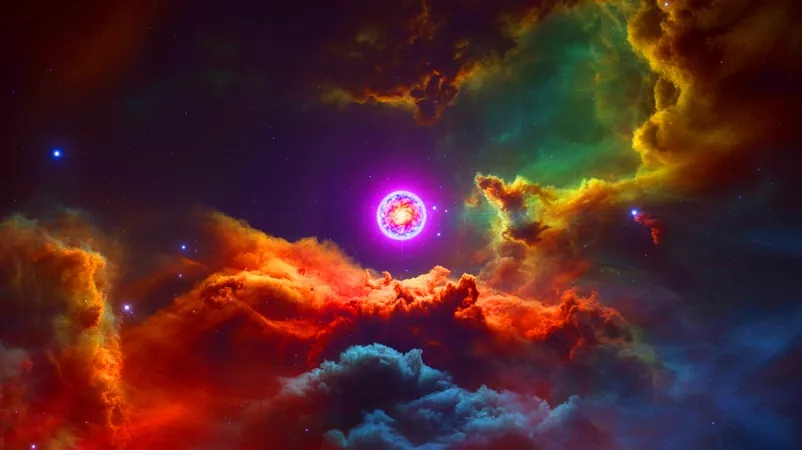
Astronomers Capture Stunning Young Star Formation 26,000 Light Years Away
2025-09-09
Author: Sophie
A Celestial Breakthrough
In a groundbreaking achievement, Japanese astronomers have unveiled vivid images of a young star forming in a distant sector of our Milky Way galaxy. Utilizing the Atacama Large Millimeter/submillimeter Array (ALMA) in Chile, they focused on a protostar affectionately dubbed Sh 2-283-1a SMM1. Situated an astonishing 26,000 light-years from our Sun and 51,000 light-years away from the galactic center, this discovery provides an extraordinary look into the cosmic processes of star formation in chemically distinct environments.
Revealing Cosmic Jets
The ALMA observatory allowed researchers to zoom in on Sh 2-283-1a SMM1, an emerging star shrouded in its own gas and dust. They captured remarkable images of fast-moving jets of gas shooting out from the star in opposite directions, along with slower-moving outflows that occur in irregular bursts every 900 to 4,000 years. This cyclical process is vital for star growth, helping stars to shed excess mass and angular momentum while gathering more material from their surrounding disks.
A Chemical Mystery Unfolded
While similar events have been noted in closer star-forming regions, this research marks the first occurrence of such jets being resolved in a star so far from the galactic core. A closer examination of the chemical makeup revealed a strikingly lower ratio of silicon monoxide to carbon monoxide compared to stars nearer to the center, hinting that the shock chemistry and dust characteristics differ in these more distant areas, where heavy elements are less prevalent.
An Exceptional Finding
Sh 2-283-1a SMM1 is an exceptional research subject. With a luminosity about 6,700 times greater than the Sun, it's classified as an intermediate-to-high-mass star. The discovery of a 'hot core' — a chemically rich and warm region nearby — adds another layer of intrigue, as such cores are rarely detected in the outer limits of the galaxy.
Hints of Planet Formation
Adding to the excitement, ALMA also discovered complex organic molecules within the protostar system, raising tantalizing possibilities for planet formation. Besides Sh 2-283-1a SMM1, molecular outflows from four other protostars were identified, reinforcing the idea that star formation is indeed thriving in these remote and chemically primitive regions.
The Ubiquity of Star Formation Physics
This cutting-edge research not only demonstrates the universal physics governing star formation but also highlights the role of local chemical conditions. Lead author Toki Ikeda emphasized, "By resolving jets and outflows in this distant protostar, we can see that the same physics at play near the Sun also operates in low-metallicity environments.” This offers crucial insights into the formation of the universe's earliest stars, revealing that even in foreign cosmic conditions, fundamental processes remain consistent.
Looking Ahead
Fueled by these revelations, the research team is eager to explore more protostars in the galaxy’s outer reaches. They aim to determine whether ejection cycles and molecular compositions are influenced by metallicity, promising more discoveries that could deepen our understanding of star formation in varied cosmic frameworks.
This groundbreaking study not only enhances our knowledge of stellar evolution but also raises new questions about the potential for life beyond Earth. As we pursue further discoveries in the vast universe, who knows what other secrets of star formation will emerge?









 Brasil (PT)
Brasil (PT)
 Canada (EN)
Canada (EN)
 Chile (ES)
Chile (ES)
 Česko (CS)
Česko (CS)
 대한민국 (KO)
대한민국 (KO)
 España (ES)
España (ES)
 France (FR)
France (FR)
 Hong Kong (EN)
Hong Kong (EN)
 Italia (IT)
Italia (IT)
 日本 (JA)
日本 (JA)
 Magyarország (HU)
Magyarország (HU)
 Norge (NO)
Norge (NO)
 Polska (PL)
Polska (PL)
 Schweiz (DE)
Schweiz (DE)
 Singapore (EN)
Singapore (EN)
 Sverige (SV)
Sverige (SV)
 Suomi (FI)
Suomi (FI)
 Türkiye (TR)
Türkiye (TR)
 الإمارات العربية المتحدة (AR)
الإمارات العربية المتحدة (AR)